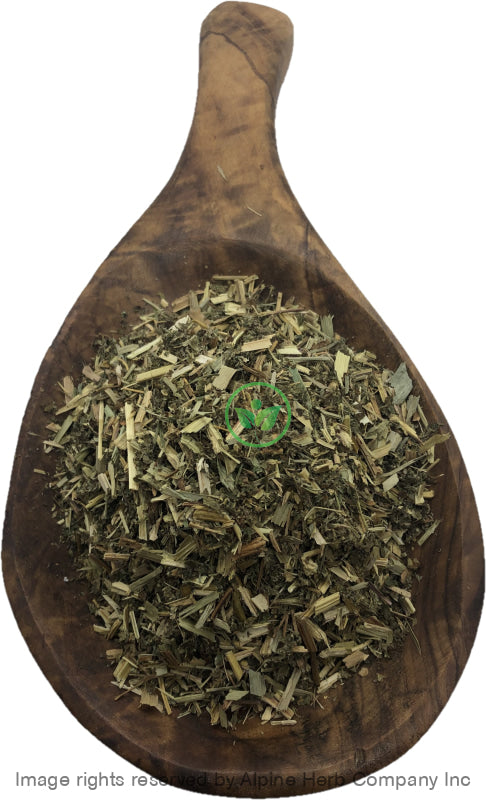Meadowsweet Herb Cut Alpine Herb Company Inc.
$ 8,99 $ 5,39
Botanical Name: Filipendula ulmaria
Common Name:
- English: Dropwort, Filipendula, Mead wort
- Also, known as Madesuss, Ulmaire, Ulmaria
Origin: Poland
Harvested: Wild
Parts Used: Leaves & Stems
General Information:
Filipendula ulmaria, commonly known as meadowsweet or mead wort is a perennial herb in the family Rosaceae that grows in damp meadows. Erect stems are 2 – 4 feet tall. Fernlike leaves are downy underneath and dark green on top, 1 to 4 inches long. Meadowsweet has delicate, graceful, creamy-white flowers clustered close together in irregularly branched cymes, having a very strong, sweet smell. Meadowsweet’s display of yellowish-white flowers is an essential part of the Finnish summer. It doesn’t flower until it’s nine or ten years old, but it compensates with its fine display. On warm summer days the inflorescence’s cloyingly sweet, slightly vanilla-like fragrance attracts clouds of pollinating insects. The flowers have no nectar, but pollinators are rewarded with pollen, which they spread from flower to flower and which also spreads on the wind. It is native throughout most of Europe and Western Asia. It has been introduced and naturalized in North America, found in woodland gardens with dappled shade, bog gardens, moist banks, and meadows across North America.
It was also known as bridewort, because it was strewn in churches for festivals and weddings, and often made into bridal garlands. Meadowsweet’s aromatic flowers have been used to flavour wine and beer. The fragrance of cut flowers in a vase fills the entire room. In the Roman days, meadowsweet flowers were sprinkled on the floor before feasts: where the flowers were getting crushed underfoot, their fragrance would float up. In Europe, it took its name “queen of the meadow” for the way it can dominate a low-lying, damp meadow. The name ulmaria means “elmlike”, possibly in reference to its individual leaves which resemble those of the elm (Ulmus). Like slippery elm bark. However, the genus name comes from the Latin words filum meaning a thread and pendulus meaning hanging for the root tubers in some species that hang together with threads.
How to use:
Hot Infusion:
The basic method for dried herbs and flower is, take 2-3 tablespoons of dried herb in a cup or teapot. Pour hot water over it and cover it with lid for 10-30 minutes. Hot water is needed to draw out the antioxidants, enzymes, vitamins, flavonoids, and volatile oils from the botanicals. Strain and squeeze out as much as liquid as possible and enjoy it!
Tips:
- You can sweeten your herbal tea with a bit of honey, natural fruit juice, stevia leaves powder and or licorice root powder.
- You can make ice cubes or pops by freezing tea in ice trays or pop molds.
| Unit Size | 100g, 200g, 400g, 1kg |
|---|
Prompt shipping and expert packing
Thanks to our longstanding association with UPS FedEx DHL as well as other leading global carriers, we can offer a variety shipping options. Our warehouse staff is highly trained and will be able to pack your goods in accordance with our precise and exact specifications. Your items will go through an exhaustive examination before they will be securely packaged before being delivered. We ship to hundreds of thousands of customers daily in different countries. This is a sign of our determination to become the largest online retailer worldwide. Warehouses and distribution centers are located throughout Europe as well as in the USA.
Note that orders containing multiple items are processed according to the particular item.
We will thoroughly inspect all items ordered before shipping. Most orders are shipped within 48 hours. The delivery time will be between 3 and 7 working days.
Returns
The stock market is always changing. It's not entirely managed by us since we're involved with several entities, including the factory and the storage. Therefore, the actual inventory could fluctuate at any moment. Please be aware that it is possible that your order could be out of stock after you've placed your order.
Our policy lasts for 30 days. If it's been more than 30 days since the date you purchased your item We're sorry to say that we can't offer you a full exchange or refund.
You can only return a product if it is unused and still in the same state as when you received it. The item should be in the original packaging.


































